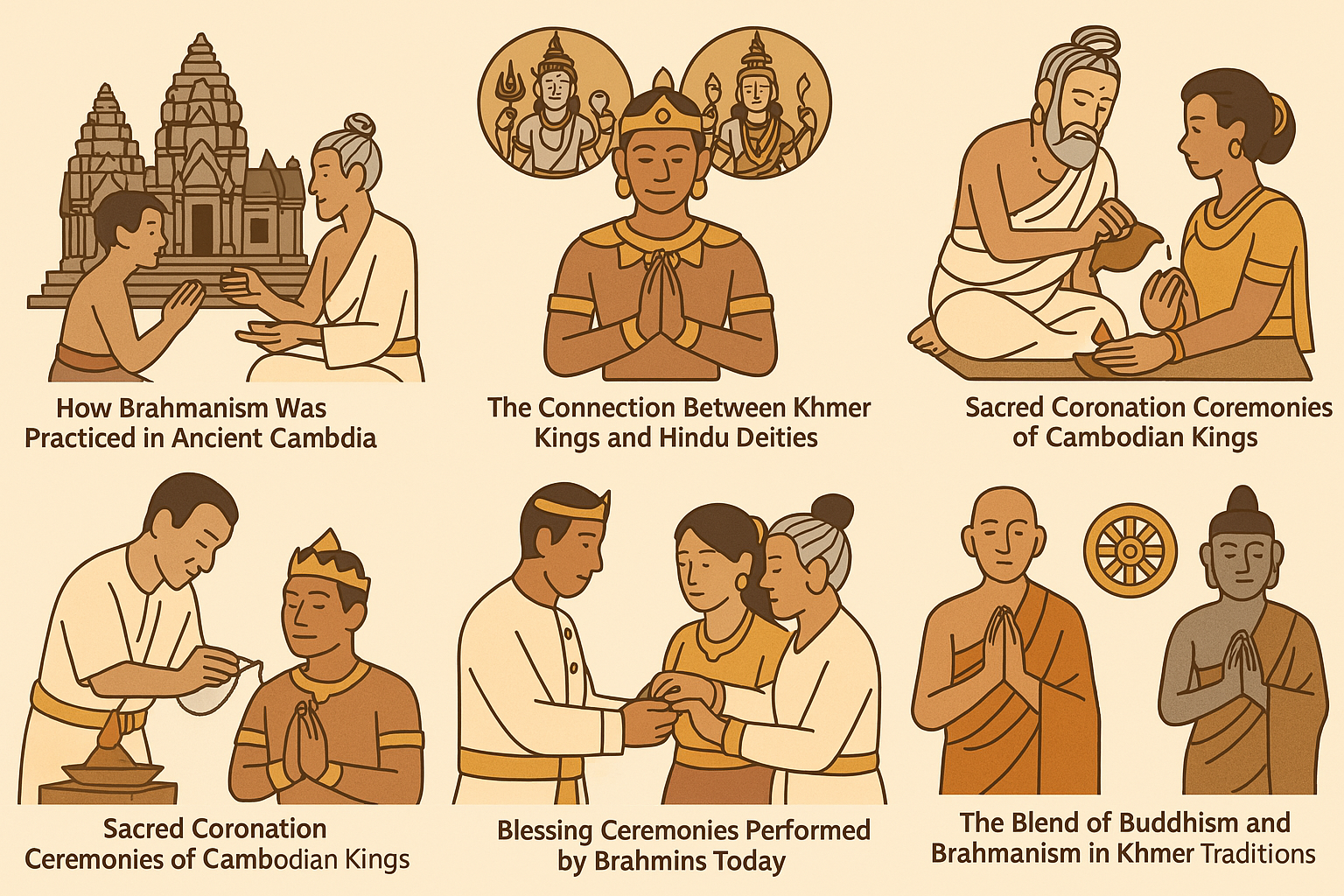Cambodia is widely recognized for its deep devotion to Theravāda Buddhism, yet beneath the golden roofs of pagodas and the chants of monks lies a far older spiritual current—animism. This ancestral belief system, which sees spirits in nature, the land, and ancestors, continues to flourish in rural Cambodian life. Rather than existing in opposition to Buddhism, animism coexists with it, forming a unique spiritual synthesis that defines the heart of rural Khmer culture.
What Is Animism, and How Does It Coexist with Buddhism?
Animism is the belief that spirits inhabit all things—trees, rivers, stones, ancestors, and even man-made objects. In rural Cambodia, this belief system is not separate from Buddhism but interwoven with it. While Buddhist teachings guide moral conduct and the path to enlightenment, animist practices address everyday concerns: protecting the home, ensuring good harvests, and warding off illness.
Many Cambodians might attend Buddhist temples regularly, yet they still make offerings to local spirits or consult a traditional healer when trouble strikes. Monks themselves may participate in rituals with animist roots, such as water blessings or house protection ceremonies. This seamless blending reflects Cambodia’s unique spiritual landscape, where Buddhism provides philosophy and animism provides protection.
The Role of Spirit Houses (Neak Ta) in Cambodian Homes
At the heart of animist practice is the spirit house, often perched near the entrance of a home, shop, or rice field. These miniature shrines, known locally as Neak Ta, are dwellings for guardian spirits who watch over specific locations or communities. It is believed that if these spirits are honored with offerings and respect, they will bless the household with prosperity and health. If neglected or offended, they may cause misfortune.
Offerings typically include incense, flowers, fruits, rice, water, and occasionally meat or alcohol, depending on the spirit’s preference. In some cases, villagers invite monks to bless the spirit house—a clear example of animism and Buddhism working hand in hand.
Protection Rituals for Homes, Farms, and Businesses
Protection rituals are an essential part of rural Cambodian life. Whether building a new home, launching a business, or starting the planting season, people seek spiritual protection through ceremonies. These might involve a Kru Khmer (traditional healer), a Buddhist monk, or both.
Common rituals include:
- “Saen Preah Phum” – blessing the land before construction.
- “Chaul Mohasat” – protective ceremonies during Khmer New Year.
- Thread-tying ceremonies – to bless and protect family members from harm.
These rituals often blend chanting, incense, holy water, and symbolic items, like colored threads or sacred herbs. They aim to pacify local spirits, repel negative energies, and invite good fortune.
Traditional Healers (Kru Khmer) and Their Spiritual Practices
Kru Khmer are respected figures in rural communities—keepers of ancestral knowledge, herbal medicine, and magical incantations. While modern medicine is spreading, many Cambodians still seek out Kru Khmer for healing both physical and spiritual ailments.
Their methods combine:
- Plant-based remedies passed down through generations.
- Astrological readings and divination.
- Blessings and chants to drive away malevolent spirits.
- Use of amulets or magical tattoos (Sak Yant) for protection.
Kru Khmer may consult with local Neak Ta spirits or perform rituals to identify spiritual imbalances. Their work remains vital, especially in regions with limited access to formal healthcare.
Ghosts and Supernatural Beliefs in Khmer Culture
Khmer folklore is rich with supernatural beings, from restless ghosts (Khmaoch) to vengeful spirits and flying female heads (Ap). Many Cambodians believe in the invisible world that exists parallel to ours—one filled with spirits of the dead, nature guardians, and unseen forces that can influence daily life.
Some common beliefs include:
- Spirits of the dead return during Pchum Ben if they are not properly honored.
- Haunted places—such as certain trees, bridges, or temples—are avoided at night.
- Sudden illness, bad dreams, or strange occurrences may be signs of spiritual disturbance.
These beliefs guide behavior and community norms. Even today, people avoid building homes where bad spirits are rumored to reside and hold ceremonies to cleanse negative energies from a location.
Offerings and Ceremonies to Appease Spirits
Offerings are central to animist practice. Whether to appease a disturbed spirit, honor ancestors, or seek blessings, Cambodians present food, drink, incense, and flowers with sincere respect. Ceremonies range from simple daily gestures to elaborate annual festivals.
Notable examples include:
- Phka Thom offerings to Neak Ta spirits during communal rituals.
- Ghost-feeding rites during Pchum Ben.
- Animal sacrifices, though now rare, still occur in some remote tribal traditions.
These offerings serve as a symbolic bridge between the material and spiritual realms, expressing gratitude, repentance, or a plea for help.
Sacred Places and Spiritual Energy in Cambodia
Across Cambodia, certain landscapes are considered inherently sacred—mountains, rivers, forests, and caves often hold spiritual power. Sites like Phnom Kulen, Preah Vihear, or ancient trees in village temples are believed to be infused with spiritual energy or inhabited by Neak Ta.
People visit these places for:
- Blessings and protection.
- Healing and spiritual guidance.
- Pilgrimage and ritual bathing in sacred waters.
Many of these places are now also Buddhist sites, but their spiritual roots trace back to pre-Buddhist animism. Respecting these landscapes is an integral part of rural spiritual life.
Conclusion: An Ancient Faith Still Alive
Though Cambodia is officially a Buddhist nation, animism continues to thrive in the countryside, shaping rituals, social behavior, and the very way people relate to the world around them. Spirit houses dot the landscape, Kru Khmer remain sought-after healers, and stories of ghosts and guardians are still told by firelight.
Rather than being a relic of the past, animism in Cambodia is a living tradition, intertwined with Buddhism and deeply embedded in the Khmer identity. It offers comfort, meaning, and a sense of connection to ancestors, nature, and the spirit world—making it one of the most enduring and profound aspects of Cambodian culture.





